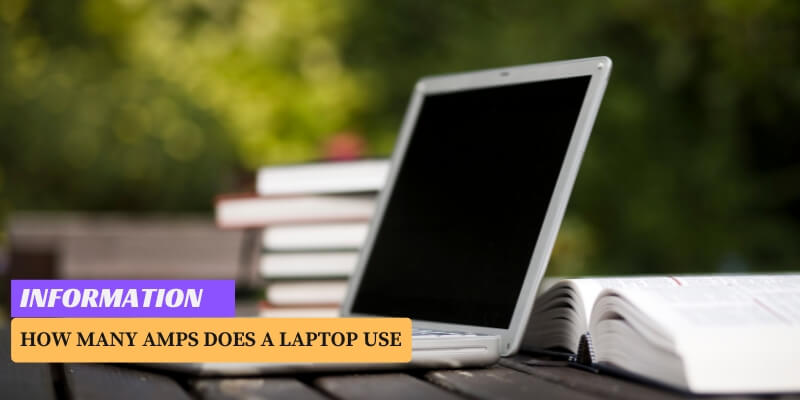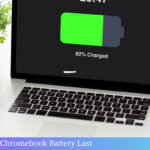A laptop typically uses around 2-3 amps of electric current. Laptops are widely used devices that have become an essential part of our daily lives.
Whether for work, entertainment, or communication purposes, laptops are relied upon to perform various tasks efficiently.
However, understanding the power consumption of a laptop is crucial to ensure its smooth operation and to prevent any potential electrical issues. The amount of electric current used by a laptop is measured in amps, which refers to the rate at which electric charges flow.
On average, a laptop uses around 2-3 amps of electric current, depending on its model and specifications.
By being aware of a laptop’s power consumption, users can make informed decisions about charging, battery life, and using appropriate electrical outlets.
We will delve into further details about the amps used by laptops and how it affects their performance and functionality.
Table of Contents
How Does Voltage And Current Affect Laptop Power Consumption?
Exploring The Relationship Between Voltage, Current, And Power Consumption
Understanding how voltage and current impact laptop power consumption is crucial for optimizing performance and maximizing battery life.
When it comes to laptops, power consumption is determined by the amount of electrical energy drawn from the power source, which is influenced by both voltage and current.
Voltage refers to the electrical potential difference or the force that drives the flow of electrons in a circuit. It is measured in volts (V) and determines the power supply’s output level.
On the other hand, current is the rate of flow of electric charge and is measured in amps (A). It represents the amount of electrical energy consumed by the laptop at any given time.
| Voltage | Current | Power Consumption |
|---|---|---|
| Higher | Lower | Higher |
| Lower | Higher | Lower |
As the table above illustrates, there is a direct relationship between voltage, current, and power consumption. When the voltage is higher, the laptop draws more current, resulting in higher power consumption.
Conversely, when the voltage is lower, the laptop draws less current, leading to lower power consumption. It’s important to note that power consumption is the product of voltage and current, showcasing the interplay between the two factors.
The Impact Of Variations In Voltage And Current On Laptop Performance And Battery Life
Variations in voltage and current not only affect laptop power consumption but also have a significant impact on performance and battery life. Here’s how:
- Performance: A laptop operating at a lower voltage and current may experience reduced performance due to insufficient power supply.
Certain tasks, such as resource-intensive software or gaming, require higher power consumption to ensure smooth operation and avoid performance issues like lag or system slowdowns. - Battery Life: Higher current draw resulting from increased voltage can significantly impact the battery life of a laptop.
The battery capacity determines how long a laptop can run on a single charge, and excessive power consumption can drain the battery more quickly. Optimal power management is crucial to prolong battery life and enable longer usage durations when away from a power source.
To optimize laptop power consumption, it is recommended to adjust power settings based on usage requirements.
For example, reducing screen brightness, disabling unused peripherals, and closing unnecessary background applications can help conserve power and extend battery life.
Additionally, using the laptop’s power-saving mode or a power management tool can further optimize efficiency by regulating voltage and current levels according to the task at hand.
Voltage and current play a vital role in determining laptop power consumption. It is essential to understand their relationship and the impact of variations on laptop performance and battery life.
By implementing power-saving practices and adjusting settings accordingly, users can ensure efficient power usage, enhanced performance, and prolonged battery life for their laptops.
Factors Affecting Laptop Power Consumption
Examining The Factors That Influence How Many Amps A Laptop Uses
Understanding the factors that affect laptop power consumption is crucial for maximizing battery life and optimizing performance.
From the central processing unit (CPU) to display brightness, several elements contribute to the amount of amps a laptop utilizes. Let’s take a closer look at these factors and their impact on power consumption.
Cpu Usage
The CPU, often referred to as the brain of the laptop, plays a significant role in power consumption. When the CPU is running intensive tasks like video editing or gaming, it requires more power and therefore uses more amps.
On the other hand, during periods of low activity, such as browsing the web or reading emails, the CPU usage and power consumption are relatively lower.
Display Brightness
The brightness level of the laptop screen directly affects power consumption. Higher brightness settings require more power as the backlight needs to emit more light.
To conserve battery life, reducing the brightness level can significantly help reduce the amount of amps the laptop uses.
Other Hardware Components That Affect Power Consumption
Various hardware components in a laptop can impact power consumption:
- Graphics processing unit (GPU): Just like the CPU, a powerful GPU used for tasks like graphic design or gaming increases power consumption.
- Hard disk drive (HDD) vs. solid-state drive (SSD): While both store data, HDDs generally consume more power due to the spinning platters and moving parts, compared to SSDs which are more power-efficient.
- RAM (Random Access Memory): Higher RAM capacity doesn’t directly influence power consumption, but more active processes running simultaneously can increase overall power usage.
- Peripherals: Devices connected through USB ports, such as external hard drives or gaming controllers, draw additional power from the laptop.
Being aware of these hardware components and their impact on power consumption allows users to make informed decisions about their laptop usage.
Adjusting settings, upgrading components, or disconnecting peripherals when not in use can help optimize power consumption.
Factors like CPU usage, display brightness, and other hardware components play a crucial role in determining the number of amps a laptop consumes.
By understanding these factors and implementing strategies to minimize their impact, users can achieve better battery life and enhance their laptop’s overall performance.
Measuring Laptop Power Consumption
Understanding how much power your laptop uses is essential for optimizing its performance and ensuring efficient energy usage.
By measuring laptop power consumption, you can make informed decisions about battery life, electricity usage, and even the environmental impact of your device.
In this section, we will explore different methods for quantifying laptop power consumption, including the use of software tools and external devices.
Different Methods For Measuring Laptop Power Consumption
When it comes to measuring laptop power consumption, there are a few different methods you can use.
Each has its benefits and considerations, and by exploring the options, you can find the approach that works best for your needs.
Using Software Tools
One common method for measuring power consumption is by using specialized software tools designed to monitor and quantify energy usage.
These tools provide real-time information about the power draw of your laptop, allowing you to understand its behavior under different conditions. One popular software tool for measuring laptop power consumption is…
However, it is important to note that software tools rely on estimations and calculations based on the laptop’s internal sensors and the operating system’s data.
While they provide a reasonably accurate measurement, there can still be some margin for error.
Using External Devices
For a more accurate and precise measurement of laptop power consumption, you can use external devices specially designed for this purpose.
These devices, often known as power meters or watt meters, connect between the laptop and its power source to measure the exact amount of power being drawn.
They provide reliable and highly accurate measurements, making them ideal for users who require precise energy consumption data.
Moreover, using external devices allows you to measure power consumption under specific conditions or while running resource-intensive tasks.
This detailed information can be valuable for understanding how different laptop activities impact energy usage and making informed decisions accordingly.
In addition to measuring power consumption, certain external devices also provide additional functionality, such as tracking voltage, current, and other electrical parameters that can help diagnose power-related issues and optimize laptop performance.
Measuring laptop power consumption is crucial for managing energy usage and understanding the impact of your laptop on the environment.
Using software tools or external devices can provide valuable insights into power utilization and inform decisions that enhance both performance and energy efficiency.
Whether you opt for software tools or external devices largely depends on your specific requirements and the level of accuracy you seek.
Typical Amp Range For Different Laptop Models
When it comes to understanding the power consumption of our laptops, one important factor to consider is the amperage or amps that a laptop uses.
By knowing the typical amp range for different laptop models, we can get a clearer picture of their power requirements and make informed decisions when it comes to charging and using them.
Exploring The Average Power Consumption Of Popular Laptop Brands And Models
Each laptop brand and model comes with its own power consumption requirements. While these requirements can vary depending on various factors such as the processor, graphics card, and screen size, we can still get a sense of the average power consumption.
Here are some popular laptop brands and their typical amp ranges:
| Laptop Brand | Average Amp Range |
|---|---|
| Dell | 1.5A – 3.5A |
| HP | 1.2A – 2.7A |
| Apple MacBook | 2A – 4A |
| Lenovo | 1.2A – 3.0A |
These are just average ranges and may vary depending on the specific model and usage scenario.
It’s important to note that power consumption can be higher when the laptop is performing intensive tasks such as gaming or video editing and lower when it’s in sleep mode or on standby.
Determining The Range Of Amps Laptops Typically Use Under Different Usage Scenarios
The power consumption of a laptop can vary depending on how it is being used. Here are a few different usage scenarios and the typical amp range that laptops fall into:
- Basic web browsing and word processing: 1.2A – 2.5A
- Streaming videos and multimedia: 2A – 3A
- Gaming and graphics-intensive tasks: 3A – 4A
- Charging the laptop while in use: 1.5A – 3.5A
It’s worth mentioning that these ranges can vary depending on the laptop brand and specifications.
It’s always a good idea to check the manufacturer’s specifications for your specific laptop model to get the most accurate information.
Tips To Optimize Laptop Power Consumption
Implementing strategies to reduce laptop power consumption and maximize battery life is crucial for busy professionals and students who rely heavily on their laptops.
By adjusting settings, managing applications, and extending battery runtime, you can significantly improve the efficiency of your device and avoid unexpected power drainage.
Implementing Strategies To Reduce Laptop Power Consumption And Maximize Battery Life
When it comes to optimizing laptop power consumption, every little adjustment counts. By implementing the following strategies, you can make sure your laptop runs efficiently while conserving battery life:
- Adjust display settings: Brightness levels play a significant role in draining your laptop’s battery. Reduce the brightness to a comfortable level and consider enabling auto-brightness to adapt to ambient lighting conditions automatically.
- Activate power-saving mode: Most laptops offer a power-saving mode that optimizes performance and reduces power consumption. Enable this mode when you’re working on less demanding tasks or running on battery power.
- Turn off Wi-Fi and Bluetooth: When not needed, disabling Wi-Fi and Bluetooth can save a considerable amount of power. Turn them off to prevent your laptop from wasting energy on unnecessary connections.
- Manage background applications: Close any unnecessary applications running in the background. These applications consume both processing power and power, leading to faster battery drain.
- Unplug unnecessary peripherals: USB devices, external hard drives, and SD cards can consume power even when not in use. Disconnect these peripherals when you’re not actively utilizing them to conserve battery life.
Practical Tips For Adjusting Settings, Managing Applications, And Extending Battery Runtime
To further extend your laptop’s battery runtime, consider the following practical tips:
- Adjust power settings: In the power settings menu, customize advanced power options to optimize energy consumption. Customize settings such as sleep modes, display timeouts, and hard drive sleep settings according to your usage patterns.
- Manage startup programs: Reduce the number of programs that launch at startup. This not only speeds up your laptop’s boot time but also minimizes power consumption during startup.
- Use battery optimization software: Consider installing battery optimization software that can analyze power usage and suggest additional tweaks to improve battery life. This software can provide valuable insights into application-specific power consumption.
- Limit background processes: Check your laptop’s task manager for any unnecessary background processes. Close applications that are hogging resources and consuming excessive power.
- Keep your laptop cool: Overheating can reduce battery life and overall performance. Ensure proper ventilation and avoid using your laptop on soft surfaces that can block airflow.
FAQs On How Many Amps Does A Laptop Use
How Many Amps Does A Laptop Use Per Hour?
A laptop typically uses around 2-3 amps per hour. However, this can vary depending on the laptop model and usage. It’s best to check your laptop’s specifications or user manual for the specific amp usage.
How Much Amp Does A Computer Use?
A computer typically uses around 0. 5 to 3 amps, depending on its components and usage.
How Many Amps Does A Laptop Charger Draw?
A laptop charger generally draws around 2 to 3 amps.
How Many Amps Does A Gaming Laptop Use?
A gaming laptop typically uses around 3-4 amps of power.
Do Laptops Use A Lot Of Electricity?
Laptops are designed to be energy-efficient, so they consume considerably less electricity compared to desktop computers.
How Many Amps Does A Laptop Typically Draw?
On average, a laptop draws between 1. 5 to 3. 0 amps, but this can vary depending on the model and usage.
Can A Laptop Overload A Circuit?
It is highly unlikely for a laptop to overload a circuit, as they typically operate within the safe limits of a standard electrical circuit.
Is It Safe To Leave A Laptop Plugged In All The Time?
Leaving a laptop plugged in all the time is generally safe, as modern laptops have built-in safeguards to prevent overcharging and protect the battery life.
How Does A Laptop’s Power Consumption Compare To A Desktop Computer?
Laptops are much more energy-efficient than desktop computers, consuming around 80% less power on average.
Can Using A Power-hungry Laptop Lead To Higher Electricity Bills?
While power-hungry laptops may consume slightly more electricity, the difference in energy usage is usually negligible and unlikely to significantly impact your electricity bill.
Conclusion of How Many Amps Does A Laptop Use
Ultimately, understanding the number of amps a laptop uses is crucial for both functionality and safety.
By determining the wattage of a laptop, you can easily calculate the amperage and ensure you have the appropriate power supply. Remember to consult your laptop’s manual or contact the manufacturer for specific details regarding your device.
Taking the time to understand your laptop’s power needs will not only prevent any potential electrical issues but also optimize its performance for a seamless user experience.






